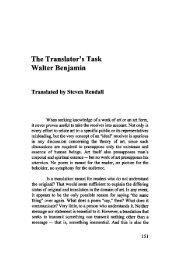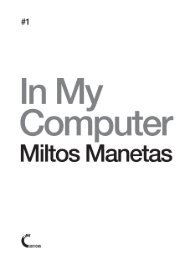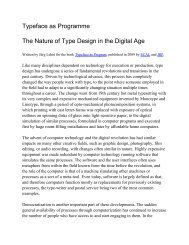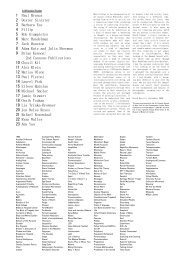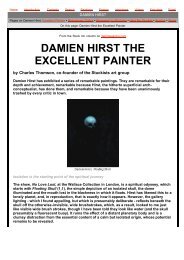Konstnären och kulturnäringarna Artists and the Arts Industries
Konstnären och kulturnäringarna Artists and the Arts Industries
Konstnären och kulturnäringarna Artists and the Arts Industries
You also want an ePaper? Increase the reach of your titles
YUMPU automatically turns print PDFs into web optimized ePapers that Google loves.
Ingrid Elam | An industry like no o<strong>the</strong>r Ingrid Elam | An industry like no o<strong>the</strong>r<br />
is high time to formulate a policy for this new area of enterprise<br />
that takes into account <strong>the</strong> mutual dependency which exists between<br />
<strong>the</strong> artistic <strong>and</strong> creative industries <strong>and</strong> o<strong>the</strong>r economic<br />
<strong>and</strong> social sectors.<br />
Within <strong>the</strong> research community, <strong>and</strong> also at <strong>the</strong> regional policy<br />
level, interest in cultural <strong>and</strong> creative industries has grown dramatically<br />
in recent years. A steady stream of anthologies <strong>and</strong><br />
reports are being published, individual cultural industries such<br />
as art halls <strong>and</strong> concert halls are being studied by economists <strong>and</strong><br />
sociologists, <strong>and</strong> action plans are being drawn up at regional <strong>and</strong><br />
municipal level. 8<br />
The place <strong>and</strong> role of <strong>the</strong> artist in cultural industries, however,<br />
is virtually unknown, as noted for instance by Raj Isar when<br />
we asked him to provide an international perspective on <strong>the</strong> subject.<br />
It is <strong>the</strong> industry itself, not <strong>the</strong> artist, that has interested<br />
researchers, <strong>and</strong> <strong>the</strong> industry ignores <strong>the</strong> complexity inherent in<br />
artistic creativity; it has adopted an increasingly economic perspective<br />
<strong>and</strong> has focused on digitally mediated art. Isar perceives<br />
a growing value conflict between <strong>the</strong> artist’s vision <strong>and</strong> market<br />
dem<strong>and</strong>, <strong>and</strong> he questions whe<strong>the</strong>r technological advance in fact<br />
benefits artistic creativity.<br />
Who is an artist? There are many definitions, <strong>the</strong> simplest<br />
among <strong>the</strong>m, perhaps, being whoever calls him/herself an artist.<br />
Ano<strong>the</strong>r is those who have acquired <strong>the</strong> requisite training,<br />
while a third is someone who mainly operates in <strong>the</strong> arts sector.<br />
When <strong>the</strong> <strong>Arts</strong> Grants Committee published a survey of artists’<br />
8 The list of research about <strong>the</strong> cultural industries is extensive. The most important<br />
names include David Throsby (2010) <strong>and</strong> Justin O´ Connor (2009).<br />
income a year or two ago, 9 anyone who belonged to an artists’<br />
organisation or who had applied for a grant from <strong>the</strong> <strong>Arts</strong> Grants<br />
Committee at some time or o<strong>the</strong>r was counted as an artist. The<br />
number of artists in Sweden is hard to pinpoint, but various<br />
studies have arrived at roughly <strong>the</strong> same figure, 30 000. This<br />
may be compared to <strong>the</strong> estimated number of people working<br />
in <strong>the</strong> cultural <strong>and</strong> creative industries 10 – 120 000 – according<br />
to a study by <strong>the</strong> Swedish Agency for Growth Policy Analysis.<br />
This would mean that three out of four people in <strong>the</strong> cultural<br />
industries are not artists.<br />
More important than counting heads is to examine how artists<br />
actually support <strong>the</strong>mselves. Concern has been voiced in <strong>the</strong><br />
culture policy debate that <strong>the</strong>re may be too few artists capable<br />
of exploiting <strong>the</strong> work opportunities offered by <strong>the</strong> market. The<br />
latest study from <strong>the</strong> <strong>Arts</strong> Grants Committee, 11 however, shows<br />
that artists are self-employed to a far greater extent than <strong>the</strong><br />
population as a whole. They also support <strong>the</strong>mselves to a greater<br />
extent than might be expected on <strong>the</strong>ir own artistic work,<br />
ra<strong>the</strong>r than on bread-<strong>and</strong>-butter jobs outside <strong>the</strong> artistic sector.<br />
In o<strong>the</strong>r words, <strong>the</strong>y are already entrepreneurs, but <strong>the</strong>y prefer<br />
not to call <strong>the</strong>mselves businesspeople. They produce meaning<br />
<strong>and</strong> artistic value, not primarily economic added value.<br />
So artists are better placed than o<strong>the</strong>rs to survive in an<br />
uncertain, changing world, but <strong>the</strong>y may need to learn what<br />
mindsets prevail out <strong>the</strong>re. Today, <strong>the</strong>re are more arts training<br />
9 Konstnärsnämnden (The Swedish <strong>Arts</strong> Grants Committee) 2009: 11.<br />
10 The Swedish Agency for Growth Policy Analysis 2009:06, p 7 ff.<br />
11 Konstnärsnämnden 2011.<br />
programmes than ever before, <strong>and</strong> those who enrol need to know<br />
something about <strong>the</strong> labour market that awaits <strong>the</strong>m – seldom<br />
with open arms. The market has definitions <strong>and</strong> value concepts<br />
that differ from those of <strong>the</strong> artist, but <strong>the</strong> boundaries are now<br />
more fluid. The gap between <strong>the</strong> artist <strong>and</strong> <strong>the</strong> business world<br />
used to be a very substantial one in Kockums’ day; young artists<br />
now have to find <strong>the</strong>ir way around a l<strong>and</strong>scape in which some<br />
advertisements could be mistaken for art <strong>and</strong> in which storytelling<br />
has become an important tool in many types of business<br />
activity. But while <strong>the</strong> idioms may be new, <strong>the</strong> phenomenon is<br />
old, as we have noted – <strong>the</strong> dividing line between art <strong>and</strong> nonart<br />
has always been open to challenge <strong>and</strong> has to be re-drawn by<br />
each new generation.<br />
It is equally important to ask what <strong>the</strong> business community<br />
needs to know about artistic activity <strong>and</strong> what o<strong>the</strong>r industries<br />
can learn from a cultural entrepreneurship that values content<br />
above money, i.e. one that produces goods regardless of <strong>the</strong>ir exchange<br />
value, as <strong>the</strong> European Commission Green Paper on <strong>the</strong><br />
cultural sector puts it. Ylva Gislén goes a step fur<strong>the</strong>r in her<br />
contribution by spotlighting <strong>the</strong> distinction between different<br />
types of work already noted by <strong>the</strong> thinkers of Antiquity. They<br />
had different words for subsistence work <strong>and</strong> work that involved<br />
acting <strong>and</strong> participating in <strong>the</strong> world. <strong>Artists</strong>’ work specifically<br />
involves participating in <strong>the</strong> world <strong>and</strong> creating meaning, but<br />
today <strong>the</strong> perception of work as a means of support has become<br />
established in <strong>the</strong> artistic sphere as well, giving rise to <strong>the</strong> requirement<br />
that art should provide <strong>the</strong> artist with a living. This<br />
requirement, Gislén argues, is deeply implicit in today’s arts<br />
training programmes.<br />
Nor is innovation necessarily a positive concept in artistic<br />
contexts; it must be filled with content <strong>and</strong> subjected to critical<br />
scrutiny. How, for instance, has <strong>the</strong> social innovation Facebook<br />
enriched <strong>the</strong> public discourse, if at all? Kate Oakley questions<br />
our present tendency to uncritically acclaim all innovation, as<br />
if <strong>the</strong>re were no such thing as bad news. <strong>Artists</strong> are far more<br />
likely to talk about change than innovation, <strong>and</strong> Oakley believes<br />
we have too much faith in <strong>the</strong> ability of art to drive innovation.<br />
Meanwhile, we are sometimes blind to innovation’s actual need<br />
of art, to how much it needs art’s creativity <strong>and</strong> familiarity with<br />
unpredictable markets.<br />
The researchers who have contributed to this anthology are<br />
mostly pessimistic about <strong>the</strong> place <strong>and</strong> prospects of <strong>the</strong> artist in<br />
today’s cultural <strong>and</strong> creative industries. This pessimism is probably<br />
a result of acquired knowledge <strong>and</strong> proven experience. Quite<br />
simply, <strong>the</strong> researchers know a great deal about developments<br />
in recent years <strong>and</strong> can adopt an historical perspective. Europe<br />
is fur<strong>the</strong>r down <strong>the</strong> line than Sweden, <strong>and</strong> much has happened<br />
22 23



